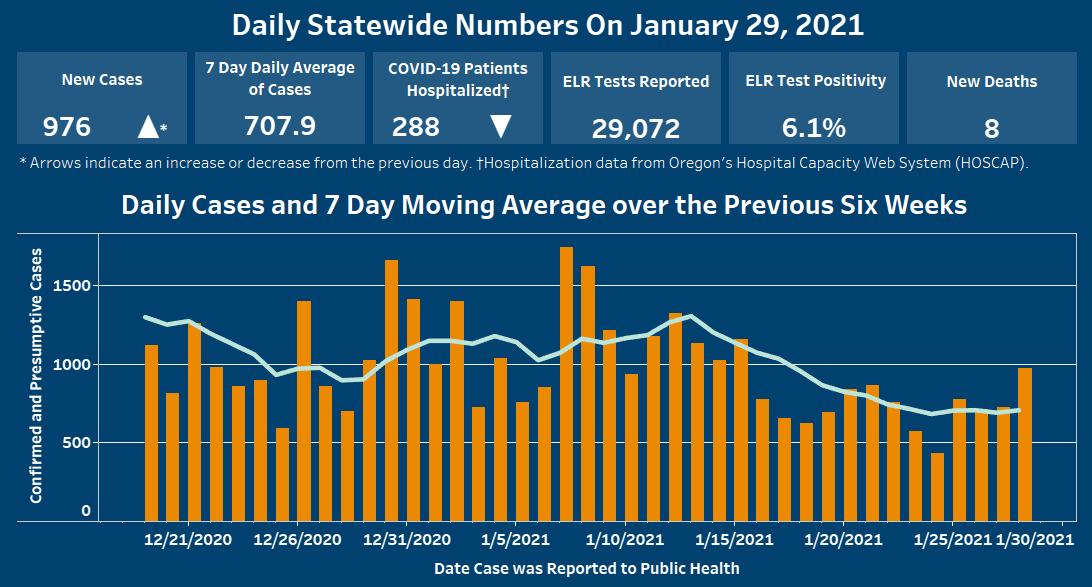There are eight new COVID-19 related deaths in Oregon, raising the state’s death toll to 1,938, the Oregon Health Authority reported today January 29, 2021.
OHA also reported 976 new confirmed and presumptive cases of COVID-19, bringing the state total to 141,729.
The new confirmed and presumptive COVID-19 cases reported are in the following counties: Baker (2), Benton (27), Clackamas (97), Clatsop (5), Columbia (10), Coos (16), Crook (5), Curry (2), Deschutes (43), Douglas (10), Harney (2), Hood River (5), Jackson (125), Jefferson (16), Josephine (20), Klamath (14), Lake (1), Lane (61), Lincoln (11), Linn (26), Malheur (10), Marion (82), Morrow (5), Multnomah (143), Polk (27), Sherman (1), Tillamook (3), Umatilla (33), Union (5), Wasco (10), Washington (135), Wheeler (2) and Yamhill (22).
OHA releases new COVID-19 forecast
The Oregon Health Authority held a media briefing today to discuss the COVID-19 vaccine and the new modeling.
The latest COVID-19 model shows a decrease in daily cases. The new report estimates that, as of Jan. 13, our statewide reproductive rate was 0.81. That means that each case of COVID-19 is being spread to less than one other person.
According to the newest forecast, if we continue on our present course of wearing masks, keeping physical distance and restricting our gathering sizes, daily COVID-19 cases will decline to an average of 420 per day, and COVID-19 related hospitalizations will decrease by 13 per day.
A 30% increase in transmission would translate to roughly 720 daily cases and 24 new hospitalizations a day, as well as 240 cases per 100,000 people by mid-February.
The new modeling does not factor in the presence of the UK variant strain of COVID-19 in Oregon.
NOTE: Today’s media briefing recording is available here and slides are available here.
To learn more about the COVID-19 vaccine situation in Oregon, visit our webpage (English or Spanish), which has a breakdown of distribution and other information.
Vaccine 101: What’s an mRNA vaccine?
The Pfizer and Moderna vaccines are both classified as “Messenger RNA (mRNA) vaccines,” but what does that mean? While this might be a new term for many, researchers have been studying and working with mRNA vaccine technology for decades. The process for making these vaccines can be standardized and produced at scale, making development faster than for a vaccine using live virus.
While mRNA vaccines seem to cause more short-term side effects than other vaccines, these effects don’t appear to be long-lasting. Unlike other vaccines, which will place a weakened germ inside our bodies to fight off infectious disease, mRNA vaccines teach our cells how to make a protein that triggers an immune response in our bodies. The COVID-19 vaccines from Moderna and Pfizer do not use the live vaccine that causes COVID-19. Just like every other vaccine available in the United States though, the mRNA vaccines have been rigorously tested for safety and effectiveness by the FDA. The clinical trials included large numbers of people from Black/African American, Hispanic/Latino and other communities of color that are systemically affected by the COVID-19 pandemic.
To learn more about the mRNA vaccines, visit the CDC’s Understanding mRNA COVID-19 Vaccines webpage or watch the video below.
Vaccine Advisory Committee makes final recommendations
Yesterday, Oregon’s 27-member COVID-19 Vaccine Advisory Committee (VAC) met for its fourth and final official meeting. They recommended four groups move forward concurrently once Oregon has vaccinated a critical mass of seniors. Those groups would be:
- Adults 16-64 with underlying health conditions
- Front-line workers (to be defined)
- Adults and youth in custody 16 years and older
- People living in low income and congregate senior housing
People who live in multi-generational households would be next in line behind these groups, followed by the general population.
As a next step, OHA staff will review the operational and legal dimensions of the recommendations before they are referred to Governor Kate Brown. The committee has an optional meeting on Feb. 2 to discuss implementation issues.
Need some emotional support?
Many of us are feeling more stressed, anxious or down than usual. But it can be hard to know if we should seek treatment for these feelings, or whether we can take actions to help ourselves feel better.
This chart from the National Institute of Mental Health can help you decide whether your symptoms are mild or severe and how much they are interfering with your daily life.
The chart offers tips for self-care activities for people experiencing mild symptoms and resources for people seeking treatment.
In addition, if you want someone to talk to, the David Romprey Oregon Warmline is available every day from 9 a.m. to 11 p.m. at 1-800-698-2392.
You can also call the Safe + Strong Helpline at 800-923-4357 (800-923-HELP). The line offers free, 24-7 emotional support and resource referral to anyone who needs it – not only those experiencing a mental health crisis. More resources are available on the Safe + Strong mental and emotional health page.
Vaccinations in Oregon: Today, OHA reported that 23,004 new doses of COVID-19 vaccinations were added to the state immunization registry. Of this total, 15,813 doses were administered on Jan. 28 and 7,191 were administered on previous days but were entered into the vaccine registry on Jan. 28.
Cumulative daily totals can take several days to finalize because providers have 72 hours to report doses administered and technical challenges have caused many providers to lag in their reporting. OHA has been providing technical support to vaccination sites to improve the timeliness of their data entry into the state’s ALERT Immunization Information System (IIS).
Oregon has now administered a cumulative total of 382,374 first and second doses of COVID-19 vaccines. To date, 614,525 doses of vaccine have been delivered to sites across Oregon.
These data are preliminary and subject to change. OHA’s dashboards provide regularly updated vaccination data, and Oregon’s dashboard has been updated today.
We share aggregated COVID-19 related deaths on OHA’s public dashboards, which are updated daily. A breakdown of today’s reported deaths by age category is included below.
New deaths by age group:
| <29 | 0 |
| 30-39 | 0 |
| 40-49 | 0 |
| 50-59 | 0 |
| 60-69 | 1 |
| 70-79 | 5 |
| 80+ | 2 |
| Total | 8 |
COVID-19 hospitalizations: The number of hospitalized patients with COVID-19 across Oregon is 288, which is three fewer than yesterday. There are 68 COVID-19 patients in intensive care unit (ICU) beds, which is four fewer than yesterday. The total number of patients in hospital beds may fluctuate between report times. The numbers do not reflect admissions per day, nor the length of hospital stay. Staffing limitations are not captured in this data and may further limit bed capacity. More information about hospital capacity can be found here.
Server maintenance means no newsletter this Sunday
OHA has scheduled time to perform server and file migration maintenance on its data management system known as the Oregon Pandemic Emergency Response Application (OPERA). OPERA serves as the state’s database for COVID-19 cases.
OPERA will be down from 10 a.m. to 10 p.m. on Saturday, Jan. 30. The scheduled work means that OHA’s Health Information Center will not be reporting information on COVID-19 cases and deaths on Sunday. We may see an increase in the total number of cases reported on Monday as laboratory results that were reported on Saturday will not be processed until Sunday.
Coronavirus Update will not publish on Sunday, Jan. 31, but will return Monday, Feb. 1. Thank you for your understanding.





